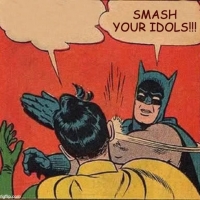DjangoBooks.com
Welcome to our Community!
Categories
- 20K All Categories
- 1.1K General
- 476 Welcome
- 59 Archtop Eddy's Corner
- 146 CD, DVD, and Concert Reviews
- 385 FAQ
- 26 Gypsy Jazz Italia
- 27 Photos
- 202 Gypsy Picking
- 21 Unaccompanied Django
- 15 Pearl Django Play-Along Vol.1
- 17 Gypsy Fire
- 45 Gypsy Rhythm
- 1.4K Gypsy Jazz University - Get Educated
- 130 Gypsy Jazz 101
- 224 Repertoire
- 218 History
- 708 Technique
- 51 Licks and Patterns
- 6 Daniel Givone Manouche Guitare Method Users Group
- 20 Eddie Lang Club
- 1.3K Gypsy Jazz Gear
- 801 Guitars, Strings, Picks, Amps, Pickups and Other Accessories
- 457 Classifieds
- 49 Recording
- 62 Other Instruments
- 18 Violin
- 5 Mandolin
- 22 Accordion
- 7 Bass
- 10 Woodwinds
- 347 Gypsy Jazz Events
- 143 North America
- 109 Europe
- 95 International










Comments
The story tells they recorded the tunes with a lot of Chianti in a very peculiar atmosphere. I wonder on how many days they made those 70 recordings and also I wonder if it was recorded at 9.30 in the morning after a long night...
Livorness did a great job with those records that were recently transcribed by the italian writer/periodist/guitarist Fabio Lossani
http://www.spartiti.biz/metodi/descri_m ... Ref=128652
Although I've never set out to prove it, I have always thought this to be true. Django's Anouman, while not a purely modal tune, predates the Mile Davis/Gil Evans Blue in Green by almost a decade. The harmonies are eerily similar.....
It would interesting to know how they approached that. Although I find Baroque type music is often the easiest to harmonize as the chords are so strongly suggested by the melody. Django probably would have had no problem picking it up by ear.
Just listened to that...it is interesting what he's doing on that solo. I really like that one actually...I see what you're saying about the bridge. Although I think that's some intentional dissonance there which is reinforced with a strong melodic line and phrasing. For me, it's that sort of device that separates the men from the boys. But I guess it depends on your sensibilities and tolerance for "outside" playing.
True....probably helped that he didn't seem to have substance abuse problems that plagued so many other great jazz musicians.
Even long before Anouman Django had long modal passages in his tunes. The A-section in Lentement mademoiselle hardly contains any harmonic movement. And then there are tunes like Rhythme Futur and Diminushing Blackness with static augmented athmosphere.
I find it almost the opposite. Bach's music was based on polyphonic voice-leading rather than melody-accompanied-by-chords. Functional chordal harmony was just about to be developed in his time, but J.S. Bach was one of the last (maybe THE last) great composer who 'till the end of his life still stuck with strict polyphony, where, if you put chords in it, the chords change in every beat - not really usable for jazz accompaniment. Bach's music has been inspiring jazz musicians a lot and some of his music has been played by jazz groups, but I think that's because the strong bass line (again, polyphonic voice-leading) lets you adapt a simpler chord sequence in some of his work.
What Django does in Bach's violin concerto is in a league of it's own of all jazzified Bach-renditions I've ever heard, it's simply brilliant. I believe Django and Stephane worked out the accompaniment together.
http://www.jazzpartout.com
On my side I was refering to a pure modal composition with "Appel Indirect" ...
I agree with kimmo when he says that Django's accompaniment on Bach is brilliant (génial in french). Here there is nothing to copy as you have to decide what lines/modulations etc... you will underline in your chords. For me it is clearly a marvel!
On Grappelli's role in working out/arranging tunes I think the fact he was able to read music and to play piano indicates he should often have had a important role in deciding what to do. For example we have to remind that many tunes were ordered by the record companies, I mean the Quintet had a list of tunes they must record. In those times the scores were available for almost each new tune but of course Django couldn't read the score so I guess Grappelli played the melody and Django worked out the chords immediately while Grappelli played. Just after that I think Django had also a great capacity to catch and transform and, in a way, to crystalize the melodies he just had listen to. The transformation he did in the melody of "In the Still of The Night" is an excellent example of this capacity. He just takes the most important phrase in the melody and he rebuilds it by developping it just as if he considered that Porter (again...) should have done it this way.
It seems that all the improvisers insist on quite playing 4 times "A" instead of marking the difference enhancing the major character of the bridge. Only the piano by quoting the melody marks such difference.
The trading fours that ends the tune indicates that Grappelli didn't stoled the chorus to Django but that it was already planned and structured as follows:
- Melody violin
- solo violin
- solo piano
- solo guitar
- trading fours violin + guitar
I see what your saying, but at first listening Django seems to be following the chords suggested by the melody. For example, look at what he plays on the first few measures. I'd say those are the most obvious chord choices for that melody as they are so clearly suggested by Bach. Not that it's easy, especially for someone with no formal training, but I do believe he would have clearly heard the changes suggested by Bach.
Yes, that is also a good example of Django's modal innovations. Rhythm Futur too (as Kimmo suggested).
http://www.youtube.com/thrip
www.denischang.com
www.dc-musicschool.com